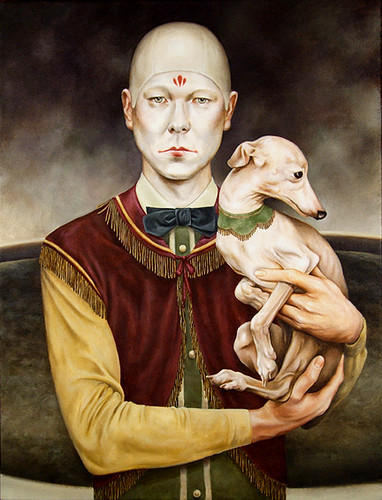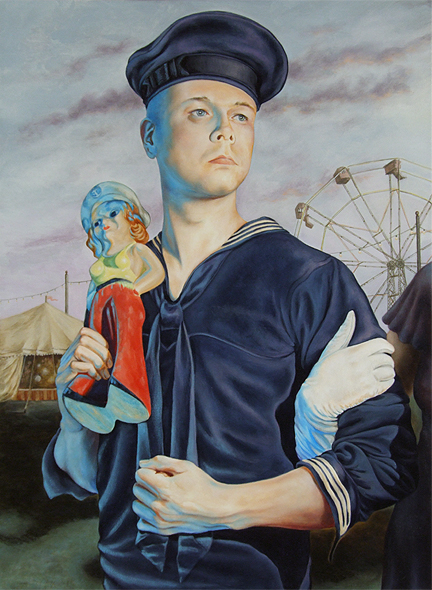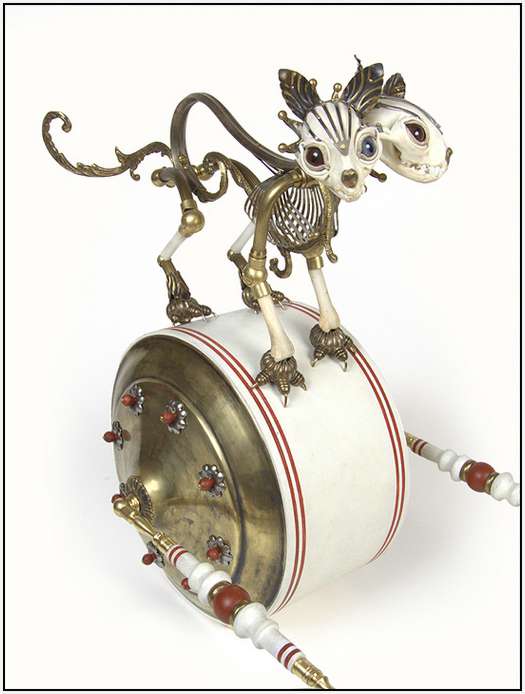upstArt
Thursday, July 12, 2012
upstArt this weekend in the Bay: Modern Eden Gallery Presents "SheWolf" and "Myth"
This weekend in the Bay: Modern Eden Gallery Presents "SheWolf" and "Myth"
Chelsea Brown has a solo exhibition, SheWolf, at Modern Eden Gallery on July 14th. The opening is 6-10 pm at Modern Eden Gallery, 403 Francisco Street.
Yuki-Onna by Melissa Morgan
The Language of Birds by Cory Benhatzel
Lucy Westenra, Dracula's Bloofer lady by Jeff Felker
Artists include: Erika Sanada, Steven Suiter, Cory Benhatzel, Lacey Bryant, Daisy Church, MAM, Yosiell Lorenzo, Layil Umbralux, Lucy Hillenbrand, Courtney Blazon, Joseph Kelly, David Camisa, Jaclyn Alderete, Corey Urlacher, Christine Benjamin, Patrushka, Peter Breese, Prunelle, Kim Gordon, Preston Thomas, Catherine Moore, Steve Belmarsh, Michelle Waters, Jeff Felker, Cody Seekins, Marisa Ware, Karyn Crisis, Kim Larson, Carisa Swenson, Kristin Forbes-Mullane, Peter Adamyan, Vahge, Mary Syring, Sean Sczepanik, Jessi Kempin, Sheri Jurnecka, Karmene K-P Hassell, Zofia Bogusz, Monty Guy, Lee Harvey Roswell, GAFAS, Kieran Collins, Cody Vrosh, Sarah Vanphravong, Ryan Gannon, Emilio Villalba, Melissa Morgan, Sergio Lopez, Marcos LaFarga, Erika Sanada and Cayetano G. Valenzuela.
Friday, July 6, 2012
#Launch2012
Launch is almost upon us here is a teaser:
#LAUNCH2012 Downtown Sacramento July 28th w/ @Chromeo @Grouplove @DJshadow @Joyformidable & more from 5432launch on Vimeo.
Thursday, June 9, 2011
Where's Waldo?
As you know I obviously have a quip against some artists' motivation. I don't have a problem with someone making money, but I find it vulgar when an artist claims to be respectable when in fact they are nothing close to it. However, some artists that do make respectable work sadly exude a sense of pretentious visual odor that forces me to either vomit or be snarky. I don't like to vomit, its too involved so I'll be snarky.
Here is the game not unlike Where's Waldo: Find the artist in the picture:
 |
| Where's Ozeri? |
I know, this one is a challenge. Can you find Yigal Ozeri among the blistering botox and Champagne sipping money whores surrounding the artist?
I think Ozeri is a talent unlike these hypocritical objectifying tools, his work blows me away every time I see it. But every time I see him I want to hide my childhood from him as he looks like that dude, Eugene Victor Tooms from the X-files that might suck my youth out of my body to reinvigorate his own crusty carcass. I get the eccentric artist look, but dude looks like a carny that just raided Tim Burton's wardrobe.
I think Ozeri is a talent unlike these hypocritical objectifying tools, his work blows me away every time I see it. But every time I see him I want to hide my childhood from him as he looks like that dude, Eugene Victor Tooms from the X-files that might suck my youth out of my body to reinvigorate his own crusty carcass. I get the eccentric artist look, but dude looks like a carny that just raided Tim Burton's wardrobe.
Here is one of my fav paintings from Ozeri the circus clown:
 |
| Yigal Ozeri |
Tuesday, June 7, 2011
Jared Joslin: Stop, Look, Glisten
Jared Joslin is like the roaring 20's circus show that I want to see. I must first admit, I'm scared of clowns, and artists that are clowns. But Jared Joslin is the kind of artist that is anything but a clown. I wish he adapted Water for Elephants to film, but he didn't and no one went to see that movie. His show "Stop, Look, Glisten" @ Firecat Projects Gallery in Chicago opens May 27th to June 18th.
 |
| Circus self portrait Jared Joslin |
I can enjoy his work, not just because it's skillful and intelligent, but there is something layered beneath the detail. It's like a semi transparent mirror into a short lived time period that was rot with sadness, yet at the same time romance. American culture was shaped so dramatically as people's entire savings were lost, while others over indulged. The party was short but the fashion, style and nostalgic permanence is so intriguing.
 |
| Shore Leave Jared Joslin |
Jared is obviously highly influenced and effected by this time period, but he has the will to illustrate those visions into meaningful snippets of a history all too soon to be lost as our grandparents pass on and we neglect to listento them. His paintings remind me of the murmuring of our past, one in which technology and industry was moving headlong into lifestyle and art.
 |
| shooting gallery Jared Joslin |
PS. Good things come in pairs. Jared's wife Jessica Joslin, is also a ridiculously bright and talented artist.
 |
| Jessica Joslin |
Friday, May 20, 2011
The Branding of Iconogrphy: Making a career out of branding things already made by others
In the previous post I attempted to articulate how the artist Haroshi has taken a pop culture icon like the Mac “Apple” and turned the idea of iconography inside out by attempting to overvalue the iconic image through the artwork itself. I think he’s successful and makes an otherwise everyday icon brand into something with more inherent value. His comment on iconography is more meaningful then the image he attempts to copy, thus creating transformative iconography. But then there is this:
Southern California artist Daniel Douke (pronounced doo-kay) not to be confused with Dookie or Robin Williams’ comic genius concerning Gucci branding turds by painting three red strips on them for the wealthy class to salivate over . However, turds do fall into various shades of brown and at times beige, so they could be accessorized with most clothing items. Trendy art goers can wear it and drink it while gleaning pretentiously over manufactured dookie or the co-opted branding of 3rd world nation children with guns.
 |
| Portriat of a Young Libertarian by Shepard Fairey |
Not only will we take a look at Douke's refinery, but also it is "Critique the Critic Day" @upstArt . Today's write up is by Victoria Dalkey (pronounced doll-key) not to be comfused with Douke.
”Since the 1970s, Douke has been making boxes and industrial objects that fool the eye into thinking they are real rather than meticulously rendered trompe l'oeil artworks. “
 |
| iMac by Douke |
Basically by placing his work in a gallery/ museum, the public is thus trompe l’oeiled into thinking it is “art” rather than an object to be placed into the recycle bin once you have set up your imac. The phrase “trompe l'oeil” is used here to elevate something that is far from interesting, or in other words refined puffery. Just saying “real looking” doesn’t allow for the kind of elitist pastiche art critics are loved for. Without refined puffery and well, French words, any run of the mill community college student that took an art history class can make a living as an art critic. I’m all for adaptive reuse and minimizing my foot print though, so save the box and use it for a receptacle for your cat dookie.
 |
| iRefuse |
Notice that the only place you’ll see this version of an imac is actually in a dumpster. Ironically and sadly, this “art” of co-opted branding is now fawned over while the original and once useful object has now been rendered obsolete in our ever tech obsessed world. So is the artwork obsolete?
“Unfortunately, a lot of people simply walk into the room and walk right out without examining these objects carefully.”
Or perhaps they are, and they know how irrelevant a counterfeit object is among the already mundaness of their lives. So the answer is yes.
“As artists such as Andy Warhol and Karen Shapiro have done, Douke elevates common commercial objects to the realm of art, reminding us that they are products of designers that epitomize our time.”
“The degree of verisimilitude that Douke achieves is truly miraculous.”
Yes indeed stupefying. Is Douke like Warhol before him, the god of commodification and monetary profit? But how truthful is it to take a product that has already been vetted as marketable to the public, and then try to recommodify that product for your own personal gain in order to fool people? It’s quality branding and advertising, but is it “art?” Is it an ode to the actual designer? I don't think so. I’d rather see an actual imac box in original condition under a plexi case with a statement from the original designers of the box. I want to know their ideas and their reasons for design.
“Challenging our assumptions about reality and artifice, Douke's marvelously rendered "Boxes" epitomize our era and the development of electronic devices that promise a "utopian" future that ironically is profit-motivated.”
I know the main market force that persuaded me to buy into the “utopian” movement of Mac products was certainly to obtain a “utopian” standard of living with free pizza and rivers of flowing Pabst.
In reality, I happily traded over my hard earned dollars hoping that I was buying art that would only increase in value, but I got stuck with a constant discharge in battery power and a crappy internets connection. Yet, how ironic is it that a consumer product would demand profit? Furthermore, is it ironic to assume that art by Warhol, Koons and even Douke is created to deliver a “Utopian” future and do we need it fêted with dead celebutants in hyper color, balloon animals and iMac boxes? I want that Utopia, thank god I can get it at any street corner MOMA.
 |
| A Warholian paean to hipsters |
But I'm a consumer and I want a utopia that is simultaniously product minded, eco freindly utilitarian and could be outfitted in every MOMA. Thank god the genious of Marcel Duchamp lives on. I give you the R. Mutt that epitomizes our time, how we spend it and how we value art.
 |
| iPottie by Marcel Duchamp |
Tuesday, May 17, 2011
The Iconography of Branding.
Young artists of today love Andy Warhol except for his postmortem work of course. But thanks to Andy Warhol making money continues to be the new art. However, with or without him pop culture is a sure money maker. Pop culture is such a deep market that it allows “artists” such as Jeff Koons to make a living alongside stiff competition.
 |
| Unabashed talent |
Yet, I want to focus less on the super villains of pop art and more on artists that stretch beyond the confines of their assembly line profit mentality. Jonathan LeVine Gallery has finally gotten it right this time with the exhibition of Japanese artist Haroshi in the Future Primitive show. Haroshi breaks the redundant boundaries and limitations within tired pop art by not just commenting on objects, but transforming pop art into new organic representations. Haroshi creates what I call “Transformative Iconography,” essentially recreating representative iconography through the morphing or manipulation of branding with new modalities. This isn’t your grandma’s soup can anymore.
 |
| Big Apple Haroshi |
His series “Apple” is not simply a co-opting of the apple icon and brand. He is not simply replicating an image; he is creating new representation through the symbolic nature of his work, craft and his own personal connection to his media. His manner of production is influenced by culture tradition in much the same way that Japanese wooden Buddhas are constructed. The layering of wood (used skateboard decks) in mosaic pattern gives a unique and ornate sculpture method to his work. Not to mention the history surrounding his used decks. To go a step future, the trendiness of being green also might score brownie points in a modern climate change context.
 |
Nike SB Dunk Haroshi |
Outwardly many of his artworks traditionally reveal how cultures place value on commodities and branded objects. Interestingly, these are constructed forms made accessible from other commodified objects completely unrelated to the constructed form, but inherent of his process and ideals of the iconography that he intends to relate to the viewer. What is fresh is what lies inside; these works have what he calls a “soul.” The true value lies within the object, a value constructed with material that the artist himself finds contextually significance. He places items unseen to the naked eye inside his works, which for the artist seem to transcend the observable and subjective nature of the work. Like the layers of skate board decks, his work is multi facetted.
Labels:
Andy Warhol,
Apple,
branding,
Future Primitive,
Haroshi,
Icon,
Iconography,
Japanese art,
Jeff koons,
Jonathan LeVine Gallery,
Mac,
Nike shoes,
Pop culture,
Skate boards,
Transformative Iconography
Tuesday, May 10, 2011
Jeremy Geddes paints in a Perfect Vacuum
Melbourne Aussie talent, Jeremy Geddes just dropped a new painting on his blog. It is the first in a series based on a book of short stories under the same title by Stanislaw Lem.
 |
| 'A Perfect Vacuum' by Jeremy Geddes |
I first stumbled upon Geddes' work a few years back by way of Josh over at Creep Machine, purveyor in all things of import in the world of so called underground art, except without the pretentions.Besides Geddes' talent and skill in depicting high detail of his figures, he is also a master of background. Too many talented artists seem to forgo the challenge of scene and the narrative that should envelop the figure.
Geddes has been focusing on sci-fi iconography of the astronaut a ’la Space Odyssey and the waste land myth for some time now. I argue this is not mere gimmickry or trendy pop. There is intelligence behind his art and as the "Low Brow" or whatever you wana call it art scene seems to get more trite and pretentious; we need this kind of work to bring us out of the crayola coma and away from computer crutch art. His figures are juxtaposed in the natural world, but in isolation and often in harm or hurt. The concept of astronaut alone in space seems to act as a foil to enhance his narrative. His worlds are often depicted as stark, cold and abandoned muted environments. The astronauts, as if wounded, attempt to engage this world only to fail. These figures are often surrounded by pigeons, known in San Francisco as homeless birds often found competing with bums for food scraps in the Mission. Here too they often seem to represent the loss of humanity and clearly contrast the stoic figures drifting in unsatisfied solace.
 |
| 'There is Glory in our Failure' Jeremy Geddes |
 |
| 'The Street' Jeremy Geddes |
Subscribe to:
Posts (Atom)




